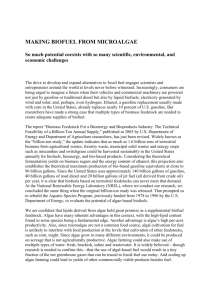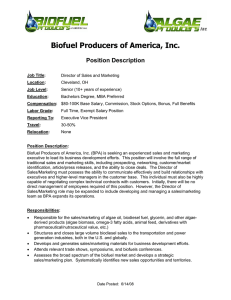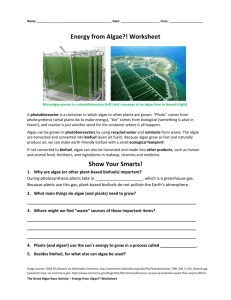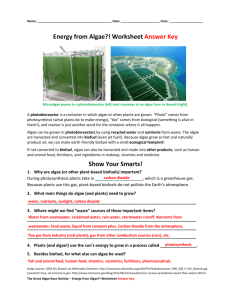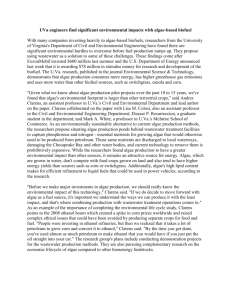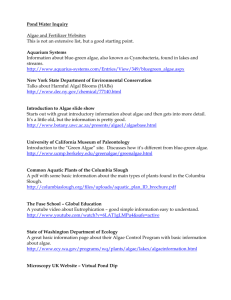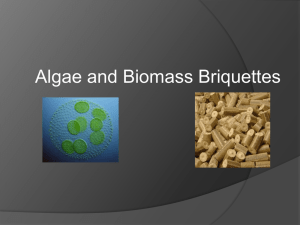Rachel Kuhaneck Biodiesel from Algae What is a Biofuel? Demand
advertisement
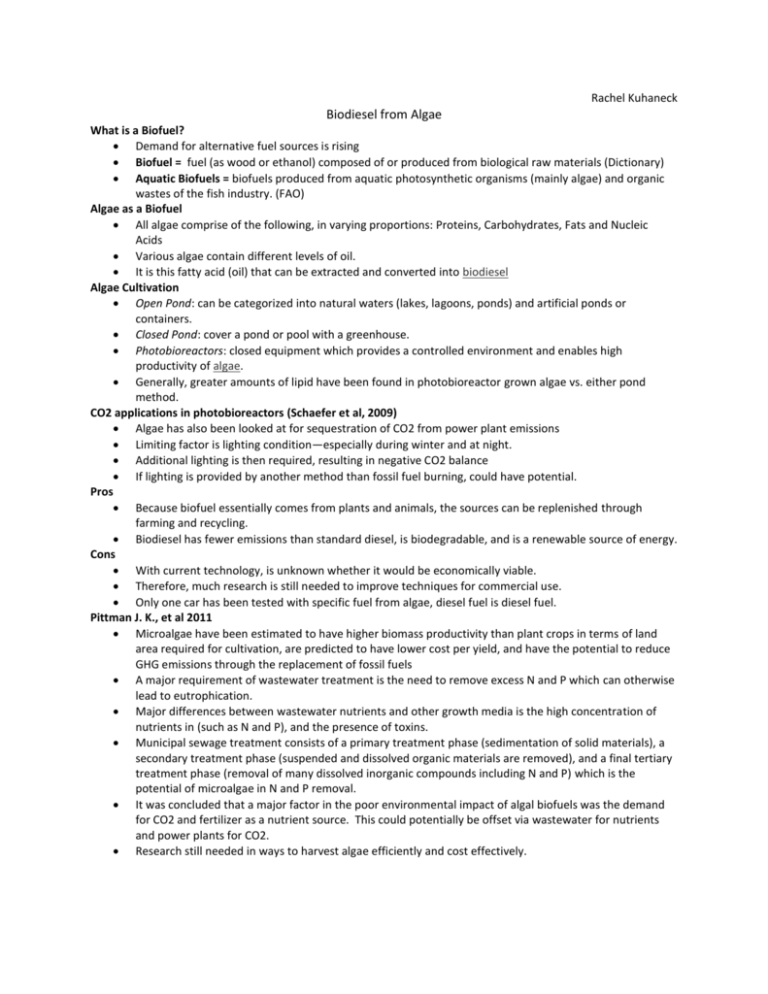
Rachel Kuhaneck Biodiesel from Algae What is a Biofuel? Demand for alternative fuel sources is rising Biofuel = fuel (as wood or ethanol) composed of or produced from biological raw materials (Dictionary) Aquatic Biofuels = biofuels produced from aquatic photosynthetic organisms (mainly algae) and organic wastes of the fish industry. (FAO) Algae as a Biofuel All algae comprise of the following, in varying proportions: Proteins, Carbohydrates, Fats and Nucleic Acids Various algae contain different levels of oil. It is this fatty acid (oil) that can be extracted and converted into biodiesel Algae Cultivation Open Pond: can be categorized into natural waters (lakes, lagoons, ponds) and artificial ponds or containers. Closed Pond: cover a pond or pool with a greenhouse. Photobioreactors: closed equipment which provides a controlled environment and enables high productivity of algae. Generally, greater amounts of lipid have been found in photobioreactor grown algae vs. either pond method. CO2 applications in photobioreactors (Schaefer et al, 2009) Algae has also been looked at for sequestration of CO2 from power plant emissions Limiting factor is lighting condition—especially during winter and at night. Additional lighting is then required, resulting in negative CO2 balance If lighting is provided by another method than fossil fuel burning, could have potential. Pros Because biofuel essentially comes from plants and animals, the sources can be replenished through farming and recycling. Biodiesel has fewer emissions than standard diesel, is biodegradable, and is a renewable source of energy. Cons With current technology, is unknown whether it would be economically viable. Therefore, much research is still needed to improve techniques for commercial use. Only one car has been tested with specific fuel from algae, diesel fuel is diesel fuel. Pittman J. K., et al 2011 Microalgae have been estimated to have higher biomass productivity than plant crops in terms of land area required for cultivation, are predicted to have lower cost per yield, and have the potential to reduce GHG emissions through the replacement of fossil fuels A major requirement of wastewater treatment is the need to remove excess N and P which can otherwise lead to eutrophication. Major differences between wastewater nutrients and other growth media is the high concentration of nutrients in (such as N and P), and the presence of toxins. Municipal sewage treatment consists of a primary treatment phase (sedimentation of solid materials), a secondary treatment phase (suspended and dissolved organic materials are removed), and a final tertiary treatment phase (removal of many dissolved inorganic compounds including N and P) which is the potential of microalgae in N and P removal. It was concluded that a major factor in the poor environmental impact of algal biofuels was the demand for CO2 and fertilizer as a nutrient source. This could potentially be offset via wastewater for nutrients and power plants for CO2. Research still needed in ways to harvest algae efficiently and cost effectively. Resources Biofuel. 2010. In Merriam-Webster Online Dictionary. Retrieved October 12, 2010 from http://www.merriam-webster.com/dictionary/biofuel Food and Agricultural Organization of the United Nations. 2010. Bioenergy: Aquatic Biofuels. Retrieved October 12, 2010, from http://www.fao.org/bioenergy/52185/en/ How Stuff Works. 2010. How Biodiesel Works. Retrieved October 12, 2010, from http://auto.howstuffworks.com/fuel-efficiency/alternative-fuels/biodiesel2.htm Oilgae. 2010. Biodiesel from Algae. Retrieved October 12, 2010, from http://www.oilgae.com/algae/ap/ap.htm Pittman J. K., Dean A. P., Osundeko O., 2011. The potential of sustainable algal biofuel production using wastewater resources. Bioresource Technology, 102, 17–25. Schaefer M., Behrendt F., Hammer T., 2010. Evaluation of strategies for the subsequent use of CO2. Frontiers of Chemical Engineering in China, 4 (2), 172 - 183
